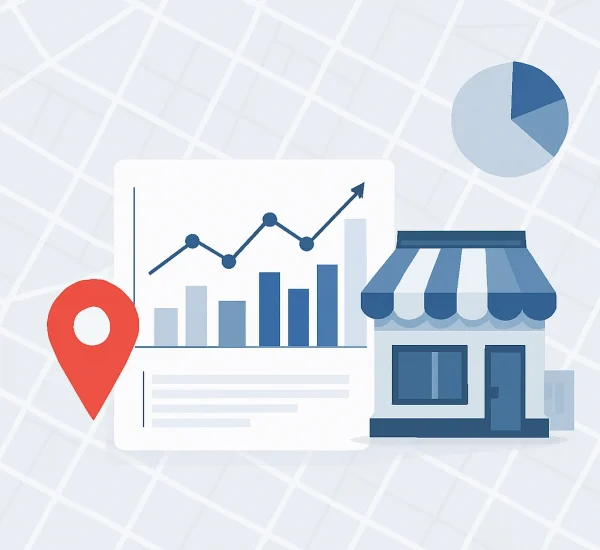Is your business struggling to stay ahead in an increasingly competitive market? You are not alone. Uncertainties are rising, and with them, potential dramatic shifts for saturated and evolving markets.
Almost any business can take an unexpected hit from looming tariffs and their potential impact on global supply chains. Besides that, fears of an economic downturn, especially after a prolonged boom phase, are increasing consumer concerns. All while businesses across the industries are still coping with the aftermath of post-COVID inflation.
In this article, we will outline how competitive data can help local businesses keep up with external threats. Understanding the actual value of competitive data goes beyond profiling competitors. But let’s start with an important clarification.
What is Competitive Market Intelligence? And how it differs.
Increasing competition and rising uncertainties require a comprehensive approach. Reacting to external market threats and their effect on consumer behavior is essential. However, having an analytical look at your competition is nothing new per se. Leveraging this knowledge and connecting competitive data with local market insights is. Competitive data can be seen in different ways:
- In Market Intelligence (MI)
This refers to the observation and analysis of consumer and market insights and other industry evolutions (trends). Businesses typically use this information to build long-term strategies.
- In Competitive Intelligence (CI)
Analyzes direct competitors, their actions, strengths, and weaknesses with the goal of improving the business’s standing. The extent can range from competitive monitoring to reverse engineering strategies to outperform them.
Local businesses can benefit from competitive insights the most. By connecting analytical findings with distinct local market characteristics, local companies leverage advantages in these highly competitive, enclosed areas.
What is competitive market intelligence?
Competitive market intelligence is a merger of competitive and market intelligence. It is a more comprehensive approach beyond a single competitive data analysis. CMI enables informed and data-driven decisions and assesses competitors under general and local market conditions. This comprehensive view provides businesses with strategic competitive insights and directly influences operations.
But how exactly?
How Data-Driven CMI Leverages Local Markets
A data-driven approach provides significant benefits under competitive market conditions. In more detail, there are several operational and strategical advantages. Both can also be synonymous to short- and long-term benefits.
CMI generally contributes to a better understanding of the local market. This allows for a more fine-grained resource allocation. Local businesses can alter their operational processes and strategies to align with the market needs. For example, businesses can implement specific staffing schedules based on foot traffic patterns.
Understanding the characteristics and differences between multiple subsidiaries is essential. Ensuring a good market fit, regardless of brand perception, is essential for local market success. Businesses often operate numerous subsidiaries, each with different customer compositions. That is where demographic and psychographic market insights can enhance traditional competitive understanding.
Moreover, competitive data helps mitigate operational risks. Continuously monitoring the market also enables the uncovering of emerging trends, threats, and often opportunities. Having this information ahead of the competition enables progressive decisions, such as changes in store layout and product offering.
It is important to understand the specifics of the surrounding market and the potential customer base when making these decisions. Strategically speaking, competitive data can have a beneficial effect on targeted product and pricing strategies. That is to align with different customer segments and preferences, increasing revenue and success.
Similarly, crafting a personalized customer experience has become increasingly important. Having competitive insights into the market also assists in various related tasks, such as customer profiling.
Having a comprehensive understanding of the potential competitors’ and one’s own customer base is critical. These insights help identify and implement key aspects of a competitive marketing strategy. Overall, competitive intelligence reduces overspending by improving the return on investment of competitive marketing efforts. However, competitive intelligence has some challenges.
About the Complexities and Challenges in CMI
Despite the various advantages of competitor analysis, competitive market intelligence is extensive and requires many resources. Numerous internal and external constraints contribute to the overall costs. The most prevalent examples are:
- Expertise and Capacity
Is there enough expertise to initialize and maintain competitive analysis efforts? Company analysis is often time-consuming and extensive. Not every business has the breath and capacity in-house.
- Scope and Extent
What is the market size, and what are the differences from other subsidiaries? Who are the competitors to monitor? How do they act under local influences? Having a clear goal helps in target setting and ensures a measurable outcome.
- Tooling
Where to acquire the data? How to continuously monitor it? How to catch trends ahead? The complexity of competitive initiatives grows exponentially. Paid and free competitor analysis tools exist, with high usability and a visual approach for competitive intelligence.
With the boundaries set, let’s look at the approach and methods of market and competitive intelligence.
Competitive Data in Practice: From Insight to Advantage
There are different approaches and scenarios where competitive data is of help. Among the most crucial parts of competitive intelligence is the as-is analysis, often referred to as benchmarking. Benchmarking is a competitor analysis that compares essential parts of multiple businesses that are similar to each other. These insights help identify gaps and opportunities. In practice, there are different frameworks to assess businesses, with the most prominent being:
- SWOT-Analysis
- Porter’s five forces
Both frameworks are strategic analysis of businesses and competitors, with the tendency of porters 5 forces being more comprehensive. Porters five forces include the strategic assessment of competitive influences, leading to a thorough market position analysis. In contrast to that, a SWOT (Strength Weakness Opportunity Threat) analysis focuses more on an internal business evaluation, with the surrounding factors more as a self-positioning.
These general, strategic assessment frameworks are crucial to every competitive analysis. However, these are often not sufficient to draw actions. That’s why both frameworks are frequently complemented by more specific methods. The following method areas can supplement general findings depending on the specific scope and hypothesis. We grouped them by focus:
- Performance
Assessment of financial key performance metrics and their change over time, e.g., revenue growth, profit margins.
- Business
Overarching KPIs including time-to-market, geographic market expansion, market penetration, and market reach.
- Customer
Deep analysis of customer behavior and sentiment. Key customer intelligence methods include surveys, sentiment analysis, and social media monitoring.
- Innovation
Monitoring and assessing publicly available competitive data, e.g., patent analysis, R&D spending analysis, official filings, product launches, and roadmaps.
Regardless of the extent of the analysis, a substantial data foundation is necessary. So, where does competitive data come from, and how do you keep track of it?
Sourcing Competitive Data
Competitive data comes in various shapes. As with all data sources, it comes in different formats, levels of detail, and timeliness. While the gathering of competitive data has been a major obstacle in the past, there are all sorts of open data and even competitive data providers available. However, this leads to an adverse problem: data overload. There are numerous data sources and provider to choose from.
Open Data Sources
With the launch of data.gov in 2009, numerous economic and business-related datasets became available for public use. For competitive intelligence, some noteworthy datasets are:
- U.S. Census
- Federal Trade Commission (FTC)
- U.S. Small Business Administration (SBA)
- Securities and Exchange Commission (SEC)
- Various State Business Filings
These datasets contain official filings, competitive information about the industry, and more specific data like mergers and acquisitions. Public datasets have no unified format, extent, and usually come in different time ranges without a clear schedule.
Third-Party Provider
Competitive data providers often come synonymous with market research. That makes sense, since a good portion of competitive market analysis is market and customer related. There are specialized suppliers of research and market data. The majority offers granular data for specific needs, while few provide comprehensive market assessment analysis.
However, the scopes broadly vary, and one supplier may not always be sufficient. Offerings range from subscriptions to one-time payments, usually at a premium price.
Competitor Sources
As we move from general to more specific information, there is no substitute for gathering competitive data directly at the source. These business channels and outlets are essential:
- Investor Relations
- News and PR sections
- Social Media
- Reports and Conference Contributions
- Specific Filings (see open data; FTC, SEC, Secretary of State)
Direct Sourcing
Like market research institutes and agencies, there is the option to gather sentiment and information from directed surveys and focus groups. However, both options require time and produce significant costs. These methods for answering specific questions don’t fit into a continuous competitive initiative.
It requires time and expertise to identify and choose the necessary and correct data to conduct analysis. Acquiring the data and shaping it can quickly exceed budgets and plans.
CMI is more than Competitive Marketing
Competitive markets require deep insights and comprehensive information to stay afloat. While competitive data is abundant, businesses are often overloaded by the volume and complexity of data sourcing and integration. Initiatives require a substantial upfront investment, with a long-term commitment. Keeping up with numerous data sources and their timely integration often exceeds available resources. This creates a dilemma that sophisticated tools try to solve.
Free and paid tools offer businesses a head start in competitive monitoring. A good example is our free Competitor Analysis tool, which lowers the barrier of entry specifically for the retail and restaurant industry. The tool and platform reduce the complexity of competitive data through a visual approach. Utilizing hundreds of data sources to create a comprehensive view of local markets and competitors.
Build on Solid Foundations
Competitor analysis is just the beginning of a competitive intelligence journey. Mapchise sources data from public and trustworthy third-party providers to create an easy-to-use and flexible solution for franchise, restaurant, and retail businesses. We blend competitive and market data and meet strategic business needs. Our platform enables flexible use cases, from site selection to market expansion.


